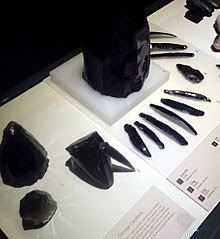Natural Glass in Antiquity
The most common and
most well-known natural glass is obsidian, a type of volcanic glass formed as a
result of the rapid cooling of lava (molten rock).
 |
| Obsidian Instruments. Turkey, 5th millennium BC. |
Being one of the first
natural materials that were widely used in everyday life, obsidian was used
both as an instrument of labor and as parts of different types of weapons —
knives, arrowheads, spears, and so on. Also, obsidian was used for the
manufacture of household items - mirrors, glasses, masks, ritual figures, and
jewelry. They used also obsidian objects as cult objects applicable during rituals,
for example, in Aztecs and Maya. Obsidian was also used in glyptics and
decorative sculpture.
A common property that
combines obsidian with ordinary glass is its ability to crack into narrow
fragments with sharp cutting or piercing edges. This property of his was
especially appreciated by primitive people in the era preceding the invention
of metal tools and weapons. It is because of this property that obsidian played
a large role in the history of mankind.
 |
| Polished Obsidian |
The Mayans and Aztecs
did not know how to smelt iron, and they made their piercing-cutting tools
precisely from obsidian. The absence of a crystal lattice has given the obsidian
the advantage thanks to which the first-ever medical, surgical instruments in
terms of their sharpness and sharpening capabilities, no metal scalpel can
still match.
The major developments
of obsidian, leading its origin from ancient times, are known in the Mexican
state of Hidalgo. Also known are old obsidian mines in the state of Guerrero.